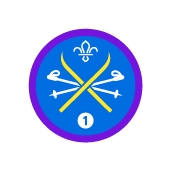
Promise
The Promise is a simple way to help young people and adults celebrate their shared Scout values. Every Scout promises to stick by these values when they become a member.
It’s important that every member has the chance to think about their Promise, and chat through its meaning, before they make their Promise for the first time during a special ceremony we call an Investiture.

Activity Badges
Master something you love, or try something shiny and new. If it spurs you on or stirs your interest, we’ve probably got a badge for it.

Challenge Awards
Scouts start small but think big, always challenging themselves to do more and be more. It starts with an award. Who knows where it might lead?
Badges to earn at home
Wanting to earn every badge you possibly can? Well the badges below are ones which we’ll probably never do within our weekly meetings – so have a go at home, keep track of your progress and show your leaders with either pictures, a log book or certificates.
Activity badges
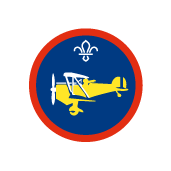
Air Researcher
How to earn your badge:
- Research one historical aspect of flight, and share what you find out with the Troop.
You might like to find out about:- the development of aviation or flight over a period of time agreed with your leader
- balloons or airships, from their first appearance to the present day
- a type of aero engine, such as a jet or piston engines in general, or a specific engine like the Rolls Royce Merlin
- the development of an aircraft type, like a Spitfire, Boeing 747, Harrier, Stealth Bomber, space shuttle or the Wessex helicopter. You could find out details about its history, role and achievements
- While you’re doing your research, visit at least one place of interest that relates to your chosen subject.
It could be a museum, an air display or an aeronautics factory. - Present what you have found out.
Your presentation should include a model that you have made based on your subject. You should also include diagrams and pictures wherever you can.
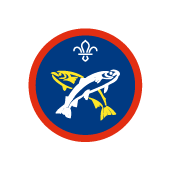
Angler
How to earn your badge:
- Learn the water safety rules and the proper precautions to take when fishing from the bank, shore line, or from a boat.
- Learn the basic hygiene precautions to take when fishing.
- Go fishing at least four times in two different places.
Make a note of:- the number of fish you caught
- species and size of your fish
- your method, tackle and bait used
- the weather and water conditions.
- Choose the correct equipment and method for where you plan to fish.
- Learn to assemble a rod, reel or pole.
- Choose the right form of bait, lure or fly for your planned fishing activity.
- Show you can cast correctly and accurately into a target area a suitable distance away, depending on the equipment you are using.
- Tie at least three different knots for your chosen method of fishing.
- Show how to correctly handle a fish, unhook it and return it into the water.
- Explain how different species of fish have different habitats.
Talk about how this, and weather conditions, can affect your method of fishing.

Cyclist
To earn your badge, complete the first two requirements:
- Use a bicycle that is properly equipped.
Keep it in good working order for at least six months. - Show that you can carry out essential maintenance and repairs, including:
- Checking and adjusting the brakes
- Checking and adjusting the gear change
- Adjusting the seat and handlebars to a correct height
- Removing a wheel and locating and repairing a puncture
- Checking and adjusting your cycle helmet
- Maintaining a set of lights
Then choose one of the following options:
- Road cycling
You can automatically complete this option if you gain Bikeability Level 2 or 3. Otherwise, here’s what you need to do for this option:- Explain what extra precautions you should take when cycling in the dark or in wet weather. Show you understand why motor vehicles take longer to stop in the wet.
- Learn the basics of first aid and what to do if an accident happens.
- Develop a working knowledge of map reading. Orientate a map using a compass or conspicuous features. Estimate distances and times taken to travel.
- Plan and carry out an all-day cycle ride of at least 40 kilometres (25 miles).
- Complete one of these:
- Show you can control a cycle along a slalom course
- Show you understand the Highway Code, including road signs and helmet use
- Off-road cycling
- Show you understand the Mountain Bike Code of Conduct.
- Show you can control your cycle over different types of terrain.
- Show you’re aware of the damage that may be caused to the environment through careless cycling across the countryside.
- Learn the basics of first aid, including the treatment of hypothermia and find out what to do in the case of an accident.
- Gain a working knowledge of map reading. Orientate a map using a compass or conspicuous features. Estimate distances and times taken to travel.
- Plan and carry out an all-day ride of at least 30 kilometres (20 miles).
- External qualifications
You can complete this option if you reach one of these standards:- The Gold Trix Award of the British Schools Cycling Association
- Level 3 Go-MTB Award from Cycling Scotland, Sustrans, CTC or Scottish Cycling MBLA.
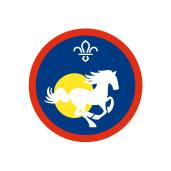
Equestrian
How to earn your badge:
- Riding
- Show you can catch a pony from a field or stable and tack up for riding.
- Walk, trot and canter a pony.
- Jump over small fences.
- Grooming and care
- Groom your pony correctly and explain why it is necessary.
- Show you know how to take care of saddlery and other equipment.
- Horse health
- Find out about some of the basic health issues affecting horses and ponies, including worms and laminitis.
- Show you have a basic knowledge of grass management.Show you recognise poisonous plants and the results of overgrazing.
- Safety
- Talk about road safety for riding.
- Explain why you need a hat, body protector, stirrup and other safety equipment.
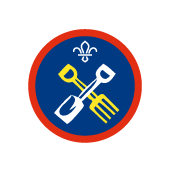
Farming
Choose 1 of the following options:
- Farming
- Learn about farming practices in your area.
- Find out about the organisation, as well as the daily and seasonal operations, of a farm of your choice.
Make a note of practices relating to livestock, crops, cultivation, rotation, machinery and labour force. - Find photos to demonstrate the changes in farming practices that have taken place over a number of years.Explain the reasons for these.
- Smallholder
- Cultivate an area of garden or an allotment for a specific length of time.
Agree this beforehand with your leadership team. - Show you’re successful in growing:
- three kinds of hardy annual flower
- three kinds of vegetable
- two kinds of bulbs, herbaceous plants, flowering shrubs or rose
- Keep a record of the work you’ve done and the results you’ve achieved.
This could include height records of the flowers, for example.
- Cultivate an area of garden or an allotment for a specific length of time.
- Livestock
- Keep any kind of livestock for at least three months.You could:
- look after farm animals or birds, and learn how they should be housed, fed and bred as well as their economic uses. Show how to handle them safely and learn about animal welfare.
- manage a hive. Bring in some of the honey you produce.
- Keep any kind of livestock for at least three months.You could:

Geocaching
How to earn your badge:
- Show that you know about the Global Positioning System (GPS) by explaining:
- how it works
- ownership and control of the system
- its benefits to society
- what factors affect its accuracy
- Programme a handheld GPS receiver to:
- find your location (grid reference, plus latitude and longitude) and record it
- enter the grid reference of a local landmark and navigate to the waypoint
- enter the latitude and longitude coordinates of a nearby point and navigate to the waypoint.Be sure to check the accuracy
- walk on a bearing using the GPS and a map
- Show that you know the difference between Ordnance Survey, and latitude and longitude coordinates.
- Using an Ordnance Survey map (1:25000 or 1:50000 scale) to plan a route of at least 4km that contains a minimum of 10 waypoints.
Talk about the features and challenges along the route. Programme the route into a handheld GPS and take the journey. - Sign up to a geocaching website.
Find out about geocaching and show that you understand what’s involved in both locating and placing a geocache. - Show that you understand the safety and environmental aspects of geocaching, such as the Highway Code, Countryside Code and the Geocaching Association of Great Britain (GAGB) guidelines.
- Find five geocaches using a GPS. At least three geocaches must be ‘multi-caches’, with at least two waypoints.
Talk about the GPS receiver’s accuracy of information provided. - With the help of an adult:
- plan, assemble and hide two caches, one of which should be a multi-cache.Make sure the location is suitable and that other navigators have proper access to the land and terrain
- either submit your caches to a geocaching website or give the details to other Scouts so they can find the caches

Hobbies
Choose one of the two options below. Complete the tasks for your chosen option to achieve this badge.
- Option 1:
- Take up a hobby or interest that you do not already have an activity badge for.
- Keep a record of your hobby for at least four months.
- Option 2:
- Make a collection or study of objects for at least four months.You could collect books or magazines, films, cards, key rings, figurines or similar.
- Talk to your Patrol Leader or your Troop about the collection or study you chose.Explain why you chose your objects and what you like about them.
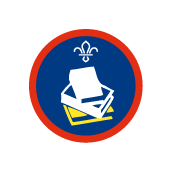
Librarian
How to earn your badge:
- Show that you know how to look after books and e-readers.
- Show that you can use a library catalogue.
- Explain how fiction and non-fiction books are arranged on the shelves.
Why are they treated differently? - Learn what is meant by a reference book or material.
Use some of these references to gather information for a journey with a purpose:- leisure leaflet or webpage
- bus or train timetable
- almanac or a who’s who
- Show how you would search for information using the internet.
- Talk to your assessor about:
- books you have read and why you enjoyed them
- information you found from books or websites
- getting books on the internet for e-readers.

Media Relations & Marketing
Choose from three of these activities to achieve this badge:
- Produce and give a presentation about Scouting.
Use audio and visual media and think about how you can make it relevant to people not involved in Scouting. - Write a press release about a Scout event that has taken place.
Send it to your local Media Development Manager so that they can get it published in the local press, radio station or community website. - Find out about local media outlets such as radio, TV, newspapers and online.
Find out what their target audience is and work out a storyline that they might be interested in featuring. - Prepare and present an audio or video package about a Scouting event or activity.
The report should be accurate, informative and reflect the adventure of Scouting. - Prepare a creative display about your Troop or Group that can be exhibited in your local library, information centre or public place.
- Interview a local public figure or someone in the local news, such as a church leader, politician or celebrity and present the interview to your Troop.
Get some advice from your Leader before contacting the person. - Produce some media which can be used within Scouting, such as a district newsletter story or a piece of website content.

Writer
How to earn your badge:
- Complete four of these activities.
Talk about your choices with an appropriate adult.- Compose a poem of at least eight lines. Discuss its meaning and construction.
- Create a short story of around 600 words.Talk about your story idea with an appropriate adult beforehand.
- Write a descriptive passage of around 600 words on a subject, agreed with an appropriate adult beforehand.
- Write a 600-word review of a favourite book, play or other work of literature and talk about it with an appropriate adult.
- Produce a published article of around 600 words in length.You could contribute to a school, faith, community or Scout magazine or write a letter to a local paper.
- Keep a diary on a subject, for a length of time agreed with an appropriate adult beforehand.
- Write a play or dramatic sketch lasting at least 10 minutes.
- Interview a local celebrity, or other notable person.Write or type out the interview to show the questions you asked and the interviewee’s replies.
- Write a letter to a pen pal (real or imaginary) of at least 600 words.
Staged badges

Musician
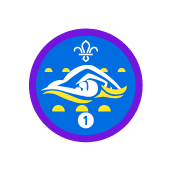
Swimmer
